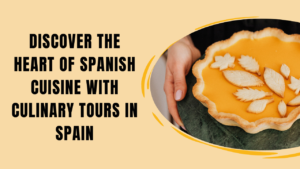Traveling through Culinary tours in Spain is a feast for the senses—and culinary tours take that experience to the next level. More than just eating great food, these tours offer a deeper connection to the country’s culture, history, and way of life. From savoring traditional dishes in local homes to exploring hidden tapas bars and bustling food markets, culinary tours give you access to authentic, off-the-beaten-path experiences. You’ll gain insights into regional ingredients, cooking methods, and the cultural significance behind every meal. Whether you’re wine tasting in La Rioja, enjoying fresh seafood on the Galician coast, or taking a cooking class in Barcelona, these experiences create lasting memories far beyond the plate.
By adding a Culinary tours in Spain to your itinerary, you’ll discover Spain not just as a traveler—but as a true participant in its rich and flavorful story.
Introduction
So, you’re planning a trip Culinary tours in Spain? Let’s make one thing clear: Spain is much more than flamenco dancers, beach holidays, and Gaudí’s masterpieces. If you want to truly experience Spain, you’ve got to taste it. Culinary tours aren’t just trendy—they’re transformative. They connect you to the soul of a place, and when that place is Spain, the journey through food is unforgettable.
The Allure of Spanish Cuisine
A Tapestry of Flavors
Spanish cuisine is like a beautifully woven tapestry—rich, colorful, and bursting with personality. From smoky paprika in chorizo to the earthy bite of Manchego cheese, every dish tells a story. It’s a flavor explosion that makes you want to savor every bite and learn what makes it tick.
Key Ingredients in Spanish Dishes
Olive Oil, Saffron, and Jamón Ibérico

These aren’t just ingredients; they’re the holy trinity of Spanish kitchens. Olive oil is practically liquid gold here, saffron gives paella its soul, and jamón ibérico—aged and cured for years—will make you question every ham you’ve eaten before.
Why Choose a Culinary Tour in Spain?
Beyond Typical Tourism
Anyone can check off touristy landmarks. But tasting anchovies straight from a fisherman’s boat in Cantabria? That’s a memory you feel. Culinary tours in Spain peel back the tourist layer and let you experience Spain from a local’s perspective.
Cultural Insight Through Cuisine
Want to know how the Moors influenced Spanish desserts? Or why tapas exist? Food is culture. A guided culinary experience offers you history, tradition, and storytelling with every course.
Local Connections and Authentic Experiences
With Culinary tours in Spain, you’re not dining at tourist traps. You’re eating in grandma’s kitchen in Andalusia or sipping cava with a winemaker in Penedès. It’s all about connection.
Regional Delights Across Spain
Northern Spain – Basque Country and Galicia
Think pintxos bars in San Sebastián or fresh octopus in Galicia. The north leans heavily into seafood, rich sauces, and cutting-edge culinary innovation.
Central Spain – Madrid and Castile

Here, comfort food rules—roast suckling pig, hearty stews, and tortilla española so good you’ll dream about it. And churros. Don’t forget the churros.
Southern Spain – Andalusia’s Rich Flavors
Flamenco, sunshine, and gazpacho. In Andalusia, Moorish influences dominate—think spices, citrus, and dishes with centuries-old roots.
Eastern Spain – Catalonia and Valencia
This is paella country. But it’s not just about rice. Catalan cuisine adds a French flair, with creamy sauces and chargrilled vegetables like escalivada.
Types of Culinary Tours in Spain
Market and Tapas Tours
You’ll stroll through vibrant local markets, chat with vendors, and then hit local bars for bites of magic—one tapa at a time.
Vineyard and Wine Pairing Tours
Culinary tours in Spain is wine heaven. From Rioja reds to Catalan cavas, wine tours let you sip your way through the countryside.
Hands-On Cooking Classes
Roll up your sleeves. You’ll learn how to make paella from scratch or master the delicate technique behind Spanish omelets.
Michelin-Starred Experiences
For serious foodies, some tours offer access to world-renowned restaurants—think molecular gastronomy and mind-blowing plating.
Unique Experiences You Shouldn’t Miss
Olive Oil Tastings
Visit olive groves, learn about cold pressing, and taste oils that range from buttery to peppery.
Iberian Ham Farm Visits
See the pigs roaming freely in oak forests and learn the centuries-old process behind jamón ibérico.
Seafood Feasts on the Coast

Eat freshly caught shellfish on the beach, grilled to perfection and paired with crisp white wine.
Participating in Local Food Festivals
Time your visit right and join in on tomato fights, garlic fairs, or chestnut roasts.
Enhancing Your Travel Through Food
Taste Memory and Emotional Connection
Science says taste is closely tied to memory. A single bite of spicy patatas bravas can instantly bring you back to that buzzing tapas bar in Barcelona.
Learning History Through the Plate
Through food, you’ll learn about Spain’s history—how invasions, trade, and geography shaped the kitchen.
Building Friendships Over Shared Meals
A long lunch with locals, laughter over wine, and shared recipes often create lifelong bonds.
How to Choose the Right Culinary Tour
Know Your Flavor Preferences
Love seafood? Head north. Prefer grilled meats and bold spices? Go south. Your taste buds should lead the way.
Duration and Budget
The duration of a tour can vary from a few hours to many days. Whether you’re backpacking or going luxury, there’s a fit for everyone.
Group Size and Guide Experience
Small groups offer intimate settings. And a good guide? They’re like your foodie fairy godparent.
Seasonal Considerations
Best Time to Visit for Food Lovers
Spring and fall are ideal—less tourist traffic and richer seasonal fare. Plus, cooler temps make eating more enjoyable.
Seasonal Ingredients and Dishes
Spring brings asparagus and tender lamb. Summer means gazpacho and cherries. Fall is all about mushrooms and roasted meats. Winter? Time for cocido and churros with thick chocolate.
Tips for Making the Most of Your Culinary Tour
Come Hungry and Curious
Obvious? Yes. But you’d be surprised how many people fill up at breakfast before a tapas crawl.
Engage with Locals
Ask questions. Compliment the chef. Learn the story behind the dish—it makes the flavors even richer.
Keep a Food Journal or Photo Diary
You’ll thank yourself later when trying to recreate that unforgettable paella or explain Spanish cider rituals to friends.
Conclusion
Culinary tours in Spain aren’t just about food—they’re about fully immersing yourself in the heartbeat of a country. Every bite, every sip, and every shared table tells a story. So ditch the guidebook for a day, grab a fork, and let your taste buds lead the way. You’ll leave not just with souvenirs, but with soulful memories written in flavor.




